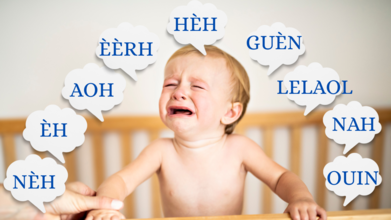- Health Conditions A-Z
- Health & Wellness
- Nutrition
- Fitness
- Health News
- Ayurveda
- Videos
- Medicine A-Z
- Parenting
- Web Stories
With Less than 1% Survival Chance, The Baby Born At 21 Weeks Survives, Breaks World Record

Credits: Andrea Mabry, The University of Alabama at Birmingham, and Butch Dill—Associated Press
A baby is considered fully developed and full-term at 39 weeks of gestation. A baby can be born anywhere between 37 and 42 weeks and can still be considered full-term. This period helps in baby's organ development like brain, lungs, and liver. It also reduces baby's health risks, promotes a better brain development and helps with other cognitive activities.
However, under certain circumstances, premature babies are also born. However, when a baby is born at 24 weeks or later, the baby has chance to survival and this chance increases with each additional week of gestation. However, babies who are born before 24 weeks face a high risk of mortality and potential long-term health issues.
A baby born before 22 weeks has a survival rate of 6%. So if a baby born in 21 weeks survives, it is no less than a miracle.
This is the story of one such miracle that happened where a baby, who had less than 1% chance of survival is now thriving and has broken the world record.
"Defied All Scientific Odds"
This is from the year 2020 when at 21 weeks, in Alabama, the most premature baby in the world, as per the Guinness World Records, was born.
Curtis Means and his twin sister, C'Asya Means, were born on July 5, 2020, at the University of Alabama at Birmingham (UAB) Hospital. Delivered at just 21 weeks and 1 day of gestation—132 days premature—the twins faced overwhelming odds, with UAB estimating their chance of survival at less than 1%. According to Guinness World Records, they were born nearly 19 weeks early.
"Numbers show that babies born so young have little to no chances of survival," said Dr. Brian Sims, a professor of pediatrics at the UAB who was the on-call physician when the twins' mother, Michelle Butler. The doctor's statement is part of UAB's official statement.
However, C'Asya did not respond to treatment and died the day after birth, but Curtis' heart rate and oxygen levels started to improve.
"We have never been able to bring a baby that young to the neonatal intensive care unit, so [Curtis] was literally the first of his kind," Sims told Guinness World Records. We were in uncharted territory."
Curtis received constant medical care that helped him breathe. His body temperature was also regulated and other care, including enough nutrition intakes were maintained. It was in about three months, when the doctors were finally able to take him off a ventilator.
Dr Colm Travers, an assistant professor in the Division of Neonatology said in a statement, "Curtis defied all scientific odds." Indeed he did. Age and birth weight are two of the most important factors in determining a newborn’s chances of survival, he explained. The odds are also higher if the baby is female, not part of a multiple birth, and if the mother received steroids before delivery to aid lung development—none of which applied in Curtis’s case. Yet, Curtis survived.
How The Baby Survived
At birth, Curtis weighed just 14.8 ounces (420 grams)—roughly one-seventh the weight of an average full-term newborn, according to Guinness World Records. Despite the odds, he grew stronger each day and was discharged from the hospital around nine months later, supported by medication, a feeding tube, and bottled oxygen.
After celebrating his first birthday, Curtis—affectionately nicknamed "Poodie" by his family—was officially recognized by Guinness World Records as the most premature surviving baby.
Six months after his discharge, Curtis’ medical team gathered outside the University of Alabama at Birmingham hospital to surprise his mother with the Guinness World Record certificate. The previous record holder, Richard Hutchinson, had been born just a month earlier, on June 5, 2020, at 21 weeks and 2 days.
Harsh Parenting Linked to 64% Higher Risk of Poor Adult Mental Health, Study Finds

There’s a reason your inner critic sounds suspiciously like your mum or dad. A new study, published in BMJ Open, has found that parents who ridicule, threaten, or humiliate their kids may be doing long-term damage not just bruising their egos but their entire mental wellbeing. According to the research, such harsh parenting increases the odds of poor adult mental health by a staggering 64 per cent. That throwaway “You’ll never amount to anything!” may echo louder in someone’s head than an actual slap.
Sticks, Stones… and Sharp Words
Led by Professor Mark Bellis of Liverpool John Moores University, the study analysed data from 20,687 adults gathered through seven different studies published between 2012 and 2024. It used the Adverse Childhood Experiences (ACE) tool to track childhood abuse and the Warwick-Edinburgh Mental Wellbeing Scale to measure how well-adjusted the now-grown children turned out to be.The participants were asked to assess their mental wellbeing over a two-week period. Scores placed them in either the high or low mental wellbeing category.
The results were eye-opening. “Our study reveals that degrading, humiliating and abusive language directed at children can have long-term mental health impacts at least as severe as those associated with physical abuse,” said Prof Bellis.
A Slap vs a Sharp Tongue
While physical abuse raised the likelihood of poor adult mental health by 52 per cent, verbal abuse outdid it at 64 per cent. The prevalence of low mental wellbeing for those who had experienced no abuse stood at 16 per cent, rising to 22.5 per cent for physical abuse, 24 per cent for verbal abuse, and 29% for both physical and verbal abuse.The numbers speak for themselves. What’s even more troubling is that while physical abuse among participants fell over time, verbal abuse has been on the rise. Those born before 1950 reported a 12 per cent prevalence of verbal abuse. That number jumped to 20 per cent among those born in or after 2000.
“Equally concerning is the trend observed over the study period where physical abuse declined but verbal abuse increased … potentially offsetting the mental health gains we might expect from reduced exposure to physical harm,” Bellis said.
In other words, just because fewer kids are getting slapped doesn’t mean they’re better off. Words, especially when used as weapons, can leave wounds that take far longer to heal.
Why It Matters Now More Than Ever
The study also found a general dip in mental wellbeing among younger generations. Those born in or after 2000 reported higher rates of poor mental health overall. So even with greater awareness about mental health, something’s going very wrong.
The researchers didn’t dig into the exact reasons for these changing abuse trends or the individual severity of abuse cases, but they made one thing clear: “Although this study does not examine the reasons for these trends, it is vital that we do not simply replace one form of childhood trauma with another,” said Bellis.
What Parents Need Besides Just ‘Don’t Do That’
Telling parents not to hit or yell at their kids isn’t enough. According to the study authors, what’s needed is practical, accessible guidance on how to build nurturing relationships. Because no parent wakes up thinking, “How can I mess my kid up today?” But when there is stress, generational trauma, or lack of support, well-meaning discipline can veer into damaging territory.
“That’s why we must go beyond telling parents what not to do and instead offer clear, practical support and guidance that allows them to raise their children through healthy, nurturing relationships,” Bellis said.
Mental health doesn’t just show up one day in adulthood. It’s shaped, layered, and often haunted by childhood experiences, especially the unkind words and undermining comments that seem small at the time but settle deep into the psyche. So if you're still dealing with anxiety or low self-worth in your thirties, it might not be ‘just you’. It could be the voice of harsh parenting, still living rent-free in your head.
Decoding Baby Cries: What Are They Really Saying?

Credits: Canva
For new parents, a baby’s cry can feel like an unsolvable riddle. Is it hunger, fatigue, discomfort, or something more complex?
While the sound of a crying baby can stir panic and helplessness, researchers say that it’s actually the first language a newborn uses to communicate. Learning to interpret these cries can build trust, reduce frustration, and strengthen the parent-child bond.
The Language of Cries
According to research by Priscilla Dunstan, babies across the world, regardless of culture or language, produce nine distinct sounds in their cries, each indicating a specific need. These are not random wails but physiological reflexes.
For example, when a baby is hungry, the tongue touches the roof of the mouth, creating a “Nèh” sound. Identifying these subtle cues early can prevent discomfort from escalating into distress.
The Nine Cries and What They Mean
Nèh – “I’m hungry”
This sound mimics a sucking motion. It’s usually the first cry parents hear, especially in the early weeks when feeding is frequent.
Èh – “I need to burp”
A short, jerky sound created when air is trapped. If you hear this after feeding, hold the baby upright and pat gently on the back.
Aoh – “I’m sleepy”
This cry often comes with yawns and a wide-open mouth. It signals that your baby needs rest soon.
Éérh – “I have a stomach ache”
Hoarse, prolonged, and strained, this cry is linked to gas or colic. Gentle massage or movement may help soothe your baby.
Héh – “I’m uncomfortable”
A soft 'h' sound may point to issues like a dirty diaper, awkward position, or rash. A quick check can resolve it.
Guèn – “I’m teething”
Often accompanied by drooling and gum rubbing, this sound means your baby may need a teething ring or gentle gum massage.
Lelaol – “I need company”
A softer, almost meowing sound—your baby simply wants interaction. Responding to this helps foster emotional security.
Nah – “I’m thirsty”
A gentler version of the hunger cry, often heard in warmer weather or when breastfeeding intervals increase.
Ouin – “Everything feels wrong”
A full-body cry when a baby is overwhelmed. Cuddling, rocking, or just holding them can bring comfort.
Beyond Sounds: Emotions And Connection
While deciphering these cues helps meet basic needs, it also supports a baby’s emotional growth. Babies experience emotions intensely, and crying is their only outlet. Your calm presence helps regulate their emotional storms, almost like serving as their temporary “prefrontal cortex”, the part of the brain responsible for emotional regulation, which develops later.
Should You Always Respond?
Some parents wonder if responding to every cry will spoil the baby. Experts say that in the early months, every cry deserves attention. It isn’t about temperament, it’s communication. As the baby matures, short self-soothing intervals can be introduced. Still, your consistent presence helps develop secure attachment and emotional resilience.
Breastfeeding Week: Breastfeed, Pumped Milk, Or Formula? Experts Weigh In On What Works The Best For A Mother And Her Child

Credits: Canva
As World Breastfeeding Week brings attention to the nourishment of newborns, the conversation around feeding methods continues to stir debates, and often, guilt. At the heart of it lies a mother’s intent to ensure her baby thrives, yet she is often met with societal pressure to follow a one-size-fits-all approach. Is direct breastfeeding truly superior to pumping? Does choosing formula equate to failure? What about maternal well-being?
To break down these questions, we spoke to Dr. Shailly Sharma, Senior Consultant Gynaecologist at Cloudnine Hospital, Faridabad, and Dr. Anjali Saxena, Senior Dietitian at PSRI Hospital, Delhi.
Breast is Best—but So is Fed
The idea that only direct breastfeeding qualifies as "best" is a common misconception. Dr. Shailly Sharma clears the air.
“The most crucial factor is that the baby receives breast milk. Whether it’s delivered directly at the breast or via a bottle (expressed milk), the nutritional and immune benefits remain largely the same,” she says.
While direct breastfeeding supports jaw development, digestion, and skin-to-skin bonding, Dr. Sharma emphasizes that pumping is an effective alternative, especially for mothers dealing with work demands, fatigue, or medical issues.
Dr. Anjana Saxena adds that, nutritionally speaking, there's only a modest difference, “Freshly expressed milk retains most of its nutrients and immune-protective components. Long storage, especially freezing, may reduce some immune factors like antibodies, but the core nutrients remain intact.”
So whether you breastfeed, pump, or both, the key is ensuring your baby is fed and healthy.
The Invisible Load: Guilt, Shame, and Emotional Toll
New mothers often find themselves navigating an emotional minefield, where breastfeeding is equated with being a ‘good mother’. The guilt of not producing enough milk or having to return to work can take a toll on their physical and mental health.
“Emotional stress, especially self-blame, can significantly affect a mother’s recovery,” explains Dr. Sharma. “It increases cortisol levels, delays healing, disrupts sleep, and may reduce milk supply further. Worse, it can impact bonding with the baby and even trigger postpartum depression.”
She advocates for “compassionate, non-judgmental support” from healthcare providers and society alike.
Dr. Saxena echoes this, “Parenting is not about perfection. When breastfeeding causes stress or health complications, choosing formula can be the healthier option, for both mother and baby.”
Can Formula Ever Compare?
While breast milk contains unique components, live antibodies, enzymes, and human milk oligosaccharides, formula has come a long way in mimicking its nutritional profile.
“Modern infant formulas are designed to closely match breast milk and meet the basic nutritional needs of infants,” says Dr. Saxena. “While they don’t contain certain bioactive compounds, they are a safe and effective alternative.”
She lists bioactives like immunoglobulin A (IgA), lactoferrin, lysozyme, and HMOs, powerful agents in human milk that boost immunity and gut health.
“Formulas today may include prebiotics and DHA, but they still fall short of replicating the dynamic nature of breast milk,” she says, adding, “This doesn’t make formula harmful, it simply means breast milk offers some extra protection.”
Still, when breastfeeding isn’t feasible, formula isn’t a compromise, it’s a responsible, sometimes life-saving, choice.
The Power of Skin-to-Skin Contact
Another overlooked element is the emotional and physiological benefit of skin-to-skin feeding, often linked with direct breastfeeding but equally valuable during bottle-feeding or pumping routines.
“Kangaroo care stabilizes the baby’s temperature and heart rate, reduces stress hormones in both mother and child, and encourages better milk let-down,” explains Dr. Sharma. “Even with expressed milk, incorporating skin-to-skin time is immensely beneficial.”
This helps nurture the parent-child bond, which contributes to overall emotional well-being, regardless of the feeding method.
When Breastfeeding Isn't an Option
Sometimes, no amount of support can overcome low milk supply. And that’s okay, say the experts.
“When a mother cannot produce sufficient milk, supplementing with formula or transitioning entirely is medically acceptable,” says Dr. Sharma. “The priority must always be nourishment and maternal well-being.”
Healthcare professionals play a vital role here. Instead of framing formula as a fallback, they should equip mothers with information on all feeding options, whether that’s formula, donor milk, or continued pumping, free from judgment.
“Mothers need clear guidance, emotional support, and respect for their choices,” she adds.
Ultimately, the debate should never overshadow the reality that every family is different. Feeding journeys can be empowering, exhausting, or even painful. But they are valid, regardless of the route taken.
Dr. Saxena puts it best, “Emotional well-being, mental health, and bonding are just as vital as physical nutrition. Mothers deserve support and compassion, not judgment.”
© 2024 Bennett, Coleman & Company Limited

